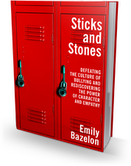It's no secret that I love a good Bravo show. So when the previews started-- and I even got a press release about Extreme Guide to Parenting-- I knew it was must see TV for me on multiple levels.

The six episodes recently finished and it's clear to me why the docu-series featuring nine families (three were so "out there" they got a full hour, and the rest were combined with two into a one-hour show) got so much press ahead of time, but not as much when the episodes aired.
It's because, somewhat shockingly, they weren't quite as out there as you might think. Sure, I didn't agree with everything said or proselytized-- and some of the families clearly need some professional help-- but three things saved the show from being a Toddlers & Tiaras, or even a Showbiz/Sports Kids Moms & Dads (earlier Bravo series that were clearly forerunners of this one).
1) Parents weren't simply presented as caricatures. The primary parent spoke about their own childhoods, often quite movingly, and it was clear how their own experiences often directly informed the decisions they make now. In short, CONTEXT was provided.
2) In almost every family one of the parents (or another close family member) tried to provide an alternative perspective. In fact, in all but one of the families a serious concession was shown being made . The one exception was in the attachment parenting family, where the family would have exposed their toddler to chicken pox instead of vaccinate, but the mom became pregnant instead (full disclosure I found this family the least likeable partly for this reason). Showing people's willingness not just to listen to other ideas, but also engage with them, was interesting-- if not a ratings coup.
3) What I also found interesting was that while these nine families tend to be extreme in their beliefs, they likely resonated with others on some level because there is a grain of truth in each of their perspectives. Is it sometimes necessary to "push" kids? Sure, we live in a culture where a story like this gets written about education, or this about men who can't give up their childhood sports dreams (full disclosure, I'm quoted here). Would it be great to show kids we shouldn't have too much stuff? Of course. Would it be great to spend even more time with your kids? Definitely. Do we want our kids to be tough but also passionate and well-rounded? Sounds great. Do we want our kids to be mentally healthy without the use of drugs, if possible? Obviously. And should we teach kids to be positive about their bodies and not ashamed? For sure [Though I will confess that nothing in the show shocked me because I have basically seen or head it all before as either a parent or researcher-- with one exception. I have NEVER seen someone collect menstrual blood, call it uterine lining, and use it to water plants. Gross!]
We all make decisions about how to balance all these forces, and more, in our lives as parents. Parenting, and life, is tough. My heart actually broke for the "indigo" child mom who is clearly trying so hard to do her best by her son (and because I had just read and reviewed The Price of Silence by Liza Long about childhood mental illness I wanted to send her a copy!). Instead of snapshots the episodes showed things over time (although the time frame wasn't always super clear) and while the editing was sometimes pointed, it still allowed people to speak for themselves a bit more. These families might not change your mind, but they will make you think and that's about all we can ask for these days in such a media saturated world.
I'll be interested to see if a second season is ordered, and if the formula changes at all. In the meantime, back to my Real Housewives viewing...



